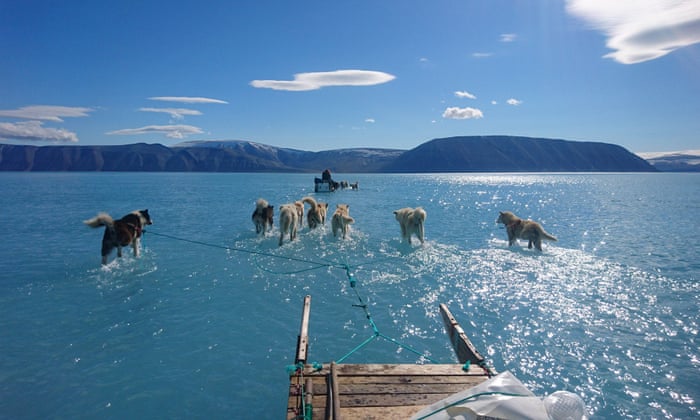Articles Menu

June 18, 2019 - Rapidly melting sea ice in Greenland has presented an unusual hazard for research teams retrieving their oceanographic moorings and weather station equipment.
A photo, taken by Steffen Olsen from the Centre for Ocean and Ice at the Danish Meteorological Institute on 13 June, showed sled dogs wading through water ankle-deep on top of a melting ice sheet in the country’s north-west. In the startling image, it seems as though the dogs are walking on water.

The photo, taken in the Inglefield Bredning fjord, depicted water on top of what Olsen said was an ice sheet 1.2 metres thick.
His colleague at the institute, Rasmus Tonboe, tweeted that the “rapid melt and sea ice with low permeability and few cracks leaves the melt water on top”.
Olsen tweeted that his team relied on traditional knowledge from local hunters and their dogs as they searched for dry spots on the ice. The team also used satellite images to plan their trip. He said the photos documented an “unusual day” and that the image was “more symbolic than scientific to many”.
Ruth Mottram, climate scientist at the Danish Meteorological Institute, told the Guardian: “This year the expedition to retrieve the instruments – by dog-sled, still the most practical way to get around in this region at this time of year – ran into a lot of standing water on the sea ice. The ice here forms pretty reliably every winter and is very thick, which means that there are relatively few fractures for meltwater to drain through. Last week saw the onset of very warm conditions in Greenland and in fact much of the rest of the Arctic, driven by warmer air moving up from the south.”
She said these conditions had let to “a lot of melting ice, on the glaciers and ice sheet, and on the still-existing sea ice”. The DMI weather station nearby at Qaanaaq airport registered a high of 17.3C last Wednesday and 15C last Thursday, which is high for northern Greenland, even in summer. Mottram cautioned that the numbers were provisional and would be subject to checking.
Melting events such as the one pictured would normally not happen until later in the summer, in late June or July. Mottram said it was too soon to say what role global warming had played, because although these temperatures were unusual, the conditions were not unprecedented and “still a weather-driven extreme event, so it’s hard to pin it down to climate change alone”.
In general, however, she said: “Our climate model simulations expect there to be a general decline in the length of the sea ice season around Greenland, [but] how fast and how much is very much dependent on how much global temperature rises.”
She said forecasts indicated that the warm conditions over Greenland would persist at least for another few days, so the dog-sled teams will face further tough going.
Greenland Melt Extent 2019, shows ice melt in Greenland 2019 versus 1981-2010 median. Photograph: National Snow and Ice Data Center (US)
The photograph emerged amid concerning temperature data from Greenland. On Saturday, the Washington Post’s Capital Weather Gang said European weather models showed that temperatures over parts of Greenland peaked at 22.2C (40F) above normal last Wednesday, the day before the photo was taken.
Above-average temperatures over nearly all of the Arctic ocean and Greenland during May have led to an early ice retreat, with the second-lowest extent of ice in the 40-year satellite record being registered, according to the US National Snow and Ice Data Centre.
The centre said that Arctic sea ice for May was 12m square kilometres (4.7m square miles), 1.13m square kilometres below the 1981-2010 average.
“The melting is big and early,” Jason Box, an ice climatologist at the Geological Survey of Denmark and Greenland, told the Washington Post.
At a local level, the sea ice melt provides significant problems for communities in Greenland, who rely on it for transport, hunting and fishing.
“Extreme events, here flooding of the ice by abrupt onset of surface melt, call for an increased predictive capacity in the Arctic,” said Olsen.
• This article was amended on 18 June. Temperatures in Greenland last Wednesday are thought to have peaked at 40F above normal. This figure was incorrectly converted to 4.4C, rather than 22C, above normal.